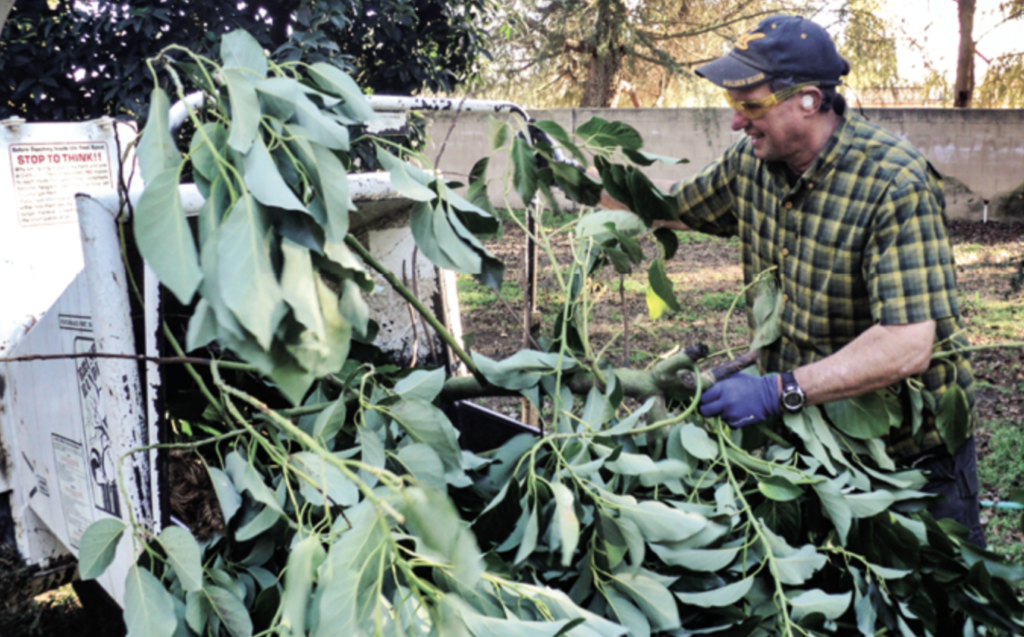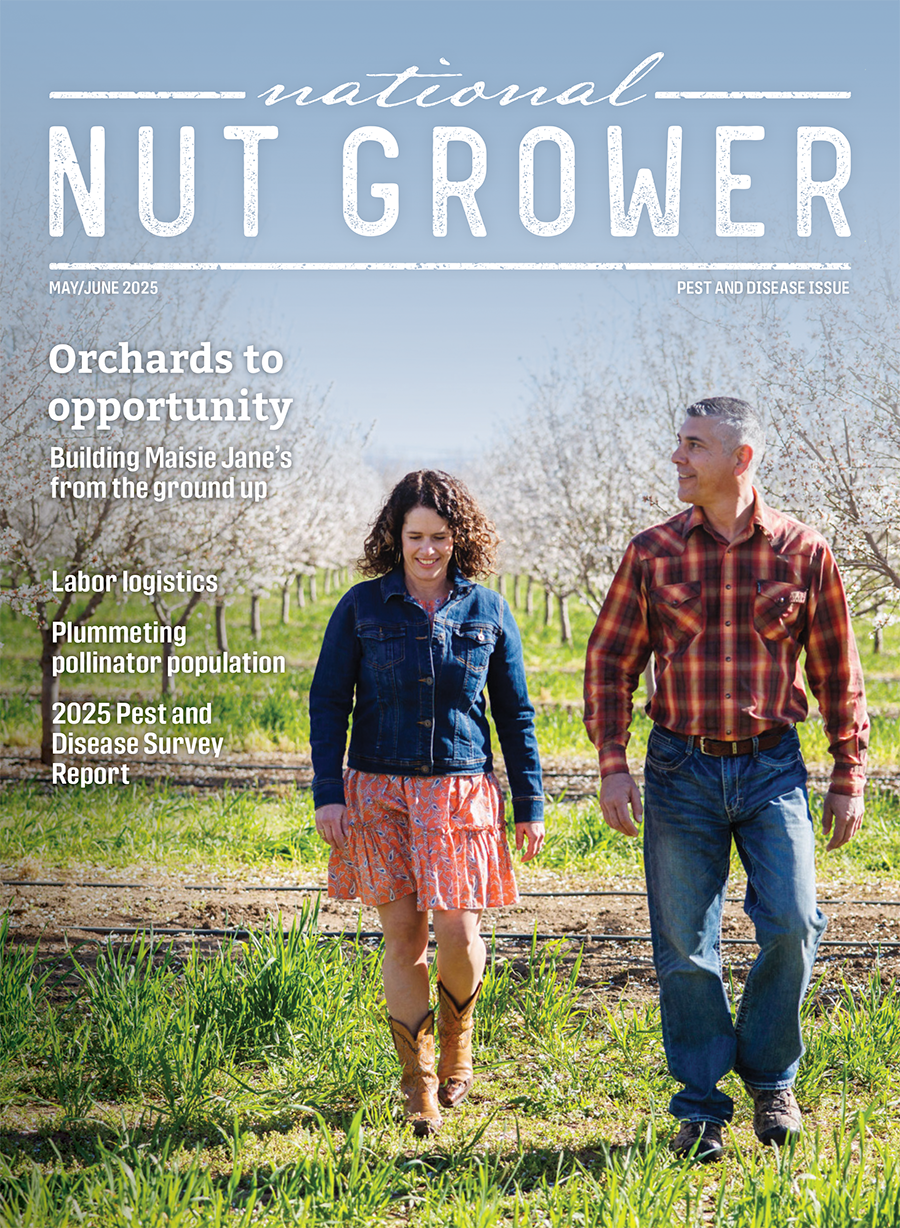
Mar 24, 2022Orchard recycling pioneer inspires almond farmers
Every day, hundreds of vehicles zoom past a tiny farm that seems out of place in suburban north Modesto. Drivers who speed by the tree-shaded property are likely unaware of its significance.
The 3-acres are recognized as the birthplace of a recycling initiative that is applauded for protecting California’s air quality while also benefiting growers in the state’s $6 billion almond industry.
Brent Holtz, a University of California Cooperative Extension farm advisor who spent much of his youth on that farm, is credited with introducing whole-orchard recycling there as a clean alternative to agricultural burning.
Instead of incinerating after-harvest brush or torching entire orchards that have reached the end of their productive lives, many almond growers today use whole- orchard recycling to turn clippings, brush and even whole trees into wood chips and recycle them into the soil. It has become a widely adopted practice among growers in the almond-rich San Joaquin Valley.
Holtz’s eventual studies with fellow UC Agriculture and Natural Resources researchers showed that whole-orchard recycling provides significant benefits for subsequent orchard plantings, including enhanced tree growth and better water and nutrient retention.
Since 2018, more than 500 growers using whole-orchard recycling in the valley have recycled 26,000-plus acres and diverted nearly 750,000 tons of wood from being burned, according to the San Joaquin Air Pollution Control District.
Agricultural burning permits are still allowed for designated days, depending on air quality forecasts. By Jan. 1, 2025, under a phaseout ordered by the California Air Resources Board, most burning will be banned in the San Joaquin Valley.
To comply with air quality standards, “the ag industries needed an alternative to burning,” said Holtz, the lead investigator for whole-orchard recycling research funded by the Almond Board of California and the California Department of Food and Agriculture.
He cited another reason many nut farmers embraced whole-orchard recycling: “Growers are environmentalists.” Many were quick to sign on, he said, “when my research showed that they could recycle their old orchards, improve soil quality and benefit their next-generation orchards.”
Holtz, 59, who holds a Ph.D in plant pathology from UC Berkeley, now resides at the north Modesto farm where whole-orchard recycling was conceived. He commutes to Stockton, where he is in his 28th year as a pomology farm advisor and 12th year as director of UCCE in San Joaquin County.
His grandfather, Leonard James, bought the Modesto property in the 1940s and converted it into a peach, walnut and almond orchard. Like other farmers, James routinely burned his almond prunings and brush at the farm. Air quality regulations did not exist then.
But Modesto’s rapid expansion – by the 1970s, the city abutted the farm and soon grew beyond it – sparked concerns, recalled Holtz, who as a teen became his grandfather’s helper.
“If we were burning and the wind direction shifted, the smoke would go into surrounding homes,” Holtz said. “People would think there was a fire. Fire trucks would respond. The firefighters would say we couldn’t burn within the city limits.”
The once-isolated farm needed a smokeless detritus-disposal system.
In 1980, Holtz’s father, Stan Holtz, bought a small wood chipper for his personal garden in Escalon. He began depositing the chips around his plants as mulch. Delighted with the results, Stan and Brent’s mother, Diana, purchased in 1989 a larger wood chipper powerful enough to chip the prunings from the north Modesto farm. Soon, mulches formed over the almond trees’ root zones.
“This mulch that was developing around the trees, you could see it and smell it and feel it, and you just knew it was becoming this good, healthy soil,” Brent Holtz said.
In 2000, he began “a small-scale scientific study” involving 3 1/2-foot tall plastic drums at the farm to determine whether an entire almond orchard could be recycled. For six years, he watched as the young trees he planted in the drums grew into healthy specimens.
In 2008, Holtz expanded his research to a 5-acre experimental orchard at the Kearney Agricultural Research and Extension Center in Fresno County. There, he recycled almond trees into the soil before replanting a new almond orchard.
“In this ongoing trial, instead of using a wood chipper, I used a 100,000-pound rock crusher called the Iron Wolf,” Holtz said. “It ground the trees up and incorporated them into the soil. Then we planted new trees where the old ones had been, and we’ve been watching them” since.
By 2015, it was clear that the new trees were growing larger, had greater trunk circumferences and yielded “significantly more almonds,” Holtz said.
As it happened, 2015 was a tough year for California’s co-generation plants, which had bought biomass from almond growers. Many were closing due to new clean-energy laws and declining profits.
“In the past, orchard-removal companies would remove the (old) orchards for free for the growers, then sell the woodchips to the co-generation plants to burn them and generate electricity,” Holtz said. “What were the growers going to do with their orchard biomass if they couldn’t burn it, or sell it to a co-generation plant?”
In October 2015, Holtz’s initial whole-orchard recycling findings were reported in a grower publication. Soon, farmers began calling Holtz, wanting to try whole-orchard recycling. “That’s when (it) took off,” he said.
In 2020, conclusions from a UC Davis research team, including Holtz’s, were published in a scientific journal. The results showed that tilling biomass from recycled trees into the soil, instead of using ashes of burned trees, increased yields of new orchards by 15% over their first five years. The whole-orchard recycling method also increased soil water retention by 30% and soil nitrogen levels by 17%.
One grower who phoned Holtz after learning about his research in 2015 was Louie Tallerico, owner of a 38-acre almond orchard in Manteca. At more than 20 years old, his trees had produced their last nut crop, he said.
Following Holtz’s instructions, Tallerico said, a contractor removed the aging trees in 2016, “ground them up and spread the chip on the soil.” In March 2017, he planted 3,800 new almond trees atop that earth.
“Farming is a slow process,” Tallerico said. “When you plant an orchard, you don’t start getting an appreciable yield until three or four years later. So, it’s too early to tell.”
But said he believes whole-orchard recycling will produce positive results over time. He said Holtz continues to visit and provide recommendations.
While Holtz still may not be getting much attention from motorists passing by his modest farm, he is now drawing notice on YouTube.
He is featured in a new six-minute documentary featurette titled “Resilience: The Whole Orchard Recycling Origin Story.” It was produced by the Almond Board of California, which continues to support his research.
“My grandfather would be very proud of the solution that came from his farm and his grandson,” Holtz said in the film. “I owe the growers who believed in me and recycled their orchards a great debt.”
– Edgar Sanchez, California Farm Bureau Federation
Brent Holtz grinds tree cuttings at the Modesto farm where he began researching whole-orchard recycling. Photo: Edgar Sanchez









